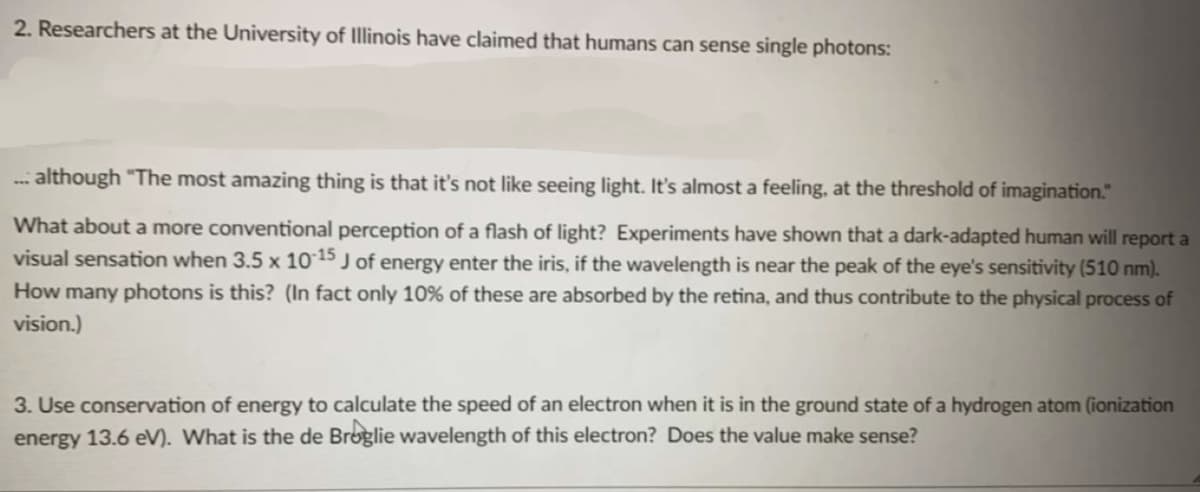What about a more conventional perception of a flash of light? Experiments have shown that a dark-adapted human will report visual sensation when 3.5 x 10-15 J of energy enter the iris, if the wavelength is near the peak of the eye's sensitivity (510 nm). How many photons is this? (In fact only 10% of these are absorbed by the retina, and thus contribute to the physical process of vision.) 3. Use conservation of energy to calculate the speed of an electron when it is in the ground state of a hydrogen atom (ionization energy 13.6 eV). What is the de Broglie wavelength of this electron? Does the value make sense?
What about a more conventional perception of a flash of light? Experiments have shown that a dark-adapted human will report visual sensation when 3.5 x 10-15 J of energy enter the iris, if the wavelength is near the peak of the eye's sensitivity (510 nm). How many photons is this? (In fact only 10% of these are absorbed by the retina, and thus contribute to the physical process of vision.) 3. Use conservation of energy to calculate the speed of an electron when it is in the ground state of a hydrogen atom (ionization energy 13.6 eV). What is the de Broglie wavelength of this electron? Does the value make sense?
Chemistry: The Molecular Science
5th Edition
ISBN:9781285199047
Author:John W. Moore, Conrad L. Stanitski
Publisher:John W. Moore, Conrad L. Stanitski
Chapter5: Electron Configurations And The Periodic Table
Section: Chapter Questions
Problem 5.ACP
Related questions
Question

Transcribed Image Text:2. Researchers at the University of Illinois have claimed that humans can sense single photons:
... although "The most amazing thing is that it's not like seeing light. It's almost a feeling, at the threshold of imagination."
What about a more conventional perception of a flash of light? Experiments have shown that a dark-adapted human will report a
visual sensation when 3.5 x 10-15 J of energy enter the iris, if the wavelength is near the peak of the eye's sensitivity (510 nm).
How many photons is this? (In fact only 10% of these are absorbed by the retina, and thus contribute to the physical process of
vision.)
3. Use conservation of energy to calculate the speed of an electron when it is in the ground state of a hydrogen atom (ionization
energy 13.6 eV). What is the de Broglie wavelength of this electron? Does the value make sense?
Expert Solution
This question has been solved!
Explore an expertly crafted, step-by-step solution for a thorough understanding of key concepts.
Step by step
Solved in 4 steps

Knowledge Booster
Learn more about
Need a deep-dive on the concept behind this application? Look no further. Learn more about this topic, chemistry and related others by exploring similar questions and additional content below.Recommended textbooks for you

Chemistry: The Molecular Science
Chemistry
ISBN:
9781285199047
Author:
John W. Moore, Conrad L. Stanitski
Publisher:
Cengage Learning

Introductory Chemistry: A Foundation
Chemistry
ISBN:
9781337399425
Author:
Steven S. Zumdahl, Donald J. DeCoste
Publisher:
Cengage Learning

Chemistry
Chemistry
ISBN:
9781305957404
Author:
Steven S. Zumdahl, Susan A. Zumdahl, Donald J. DeCoste
Publisher:
Cengage Learning

Chemistry: The Molecular Science
Chemistry
ISBN:
9781285199047
Author:
John W. Moore, Conrad L. Stanitski
Publisher:
Cengage Learning

Introductory Chemistry: A Foundation
Chemistry
ISBN:
9781337399425
Author:
Steven S. Zumdahl, Donald J. DeCoste
Publisher:
Cengage Learning

Chemistry
Chemistry
ISBN:
9781305957404
Author:
Steven S. Zumdahl, Susan A. Zumdahl, Donald J. DeCoste
Publisher:
Cengage Learning

Chemistry by OpenStax (2015-05-04)
Chemistry
ISBN:
9781938168390
Author:
Klaus Theopold, Richard H Langley, Paul Flowers, William R. Robinson, Mark Blaser
Publisher:
OpenStax

General Chemistry - Standalone book (MindTap Cour…
Chemistry
ISBN:
9781305580343
Author:
Steven D. Gammon, Ebbing, Darrell Ebbing, Steven D., Darrell; Gammon, Darrell Ebbing; Steven D. Gammon, Darrell D.; Gammon, Ebbing; Steven D. Gammon; Darrell
Publisher:
Cengage Learning

Chemistry for Engineering Students
Chemistry
ISBN:
9781337398909
Author:
Lawrence S. Brown, Tom Holme
Publisher:
Cengage Learning